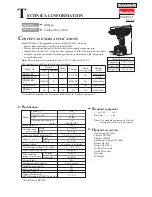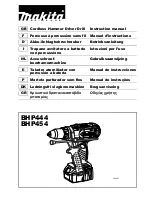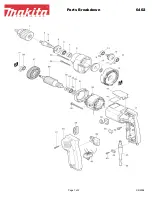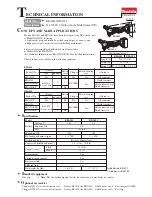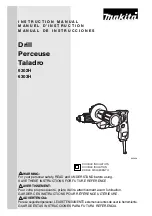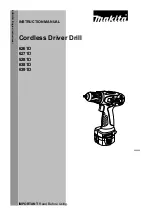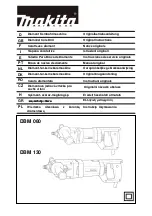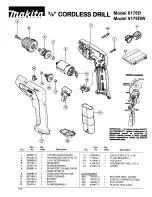
3
en
Check for misalignment or binding of moving parts,
breakage of parts and any other condition that may
affect the tools operation. If damaged, have the
tool serviced before using.
Many accidents are
caused by poorly maintained tools.
Use only accessories that are recommended by the
manufacturer for your model.
Accessories that may
be suitable for one tool may become hazardous when
used on another tool.
6. Service
Tool service must be performed only by qualified
repair personnel.
Service or maintenance performed
by unqualified personnel could result in a risk of
injury.
When servicing a tool, use only identical replace-
ment parts. Follow instructions in the Maintenance
section of this manual.
Use of unauthorized parts or
failure to follow Maintenance Instructions may create
a risk of electric shock or injury.
3. Specific safety rules and symbols
Hold tools by insulated gripping surfaces when per-
forming an operation where the cutting tool may con-
tact hidden wiring or its own cord.
Contact with a “live”
wire will make exposed metal parts of the tool “live” and
shock the operator.
Wear ear protectors when using the tool for extended
periods.
Prolonged exposure to high intensity noise can
cause hearing loss.
WARNING: Some dust created by grinding, sanding,
cutting and drilling contains chemicals known to cause
cancer, birth defects, infertility or other reproductive
harm; or serious and permanent respiratory or other
injury.
Some examples of these chemicals are: lead from
leadbased paints, crystalline silica from bricks, concrete
and other masonry products and natural stone, arsenic
and chromium from chemicallytreated lumber. Your risk
from these exposures varies, depending on how often
you do this type of work.
To reduce exposure to these
chemicals, the operator and bystanders should work
in a well-ventilated area, work with approved safety
equipment, such as respiratory protection appropriate
for the type of dust generated, and designed to filter
out microscopic particles and direct dust away from
the face and body. Avoid prolonged contact with dust.
Wear protective clothing and wash exposed areas with
soap and water.
Allowing dust to get into your mouth,
eyes, or to remain on your skin may promote absorption
of harmful chemicals.
Children must be instructed not to play with the tool.
The tool is not intended for use by children, by debil-
itated persons or those who have received no instruc-
tion or training.
G
Ensure that the workplace is well ventilated.
G
To avoid tripping and falling when working, always
lead the supply cord, extension cord and dust extrac-
tion hose away to the rear.
G
Concealed electric cables or gas and water pipes present
a serious hazard if damaged while you are working.
Accordingly, check the area in which you are working
beforehand (e.g. using a metal detector). External
metal parts of the tool may become live, for example,
when an electric cable is drilled into inadvertently.
G
Avoid contact with rotating parts.
G
Keep the grips clean, dry and free from oil and grease.
G
Always hold the tool securely with both hands on the
grips provided.
G
When not in use, the tool must be stored in a dry
place.
G
Avoid unintentional starting. Never keep a finger on
the on/off switch when carrying the tool when it is
connected to the electric supply. Check that the on/
off switch is in the "off" position before plugging the
supply cord into the electric socket.
G
Switch the tool on only once it has been brought into
the working position close to the workpiece.
G
Switch the tool off before transporting it.
G
Observe the instructions concerning lubrication and
changing insert tools.
G
Observe the instructions concerning care and main-
tenance.
G
Ensure that the insert tools used are equipped with
the appropriate connection end system and that they
are properly fitted and secured in the chuck.
G
Protect yourself against electric shock. Avoid body
contact with earthed/grounded objects, e.g. pipes,
radiators, cookers and fridges.
G
Check the condition of the supply cord and its plug
connections and have it replaced by a qualified elec-
Printed: 07.07.2013 | Doc-Nr: PUB / 5070797 / 000 / 00



















